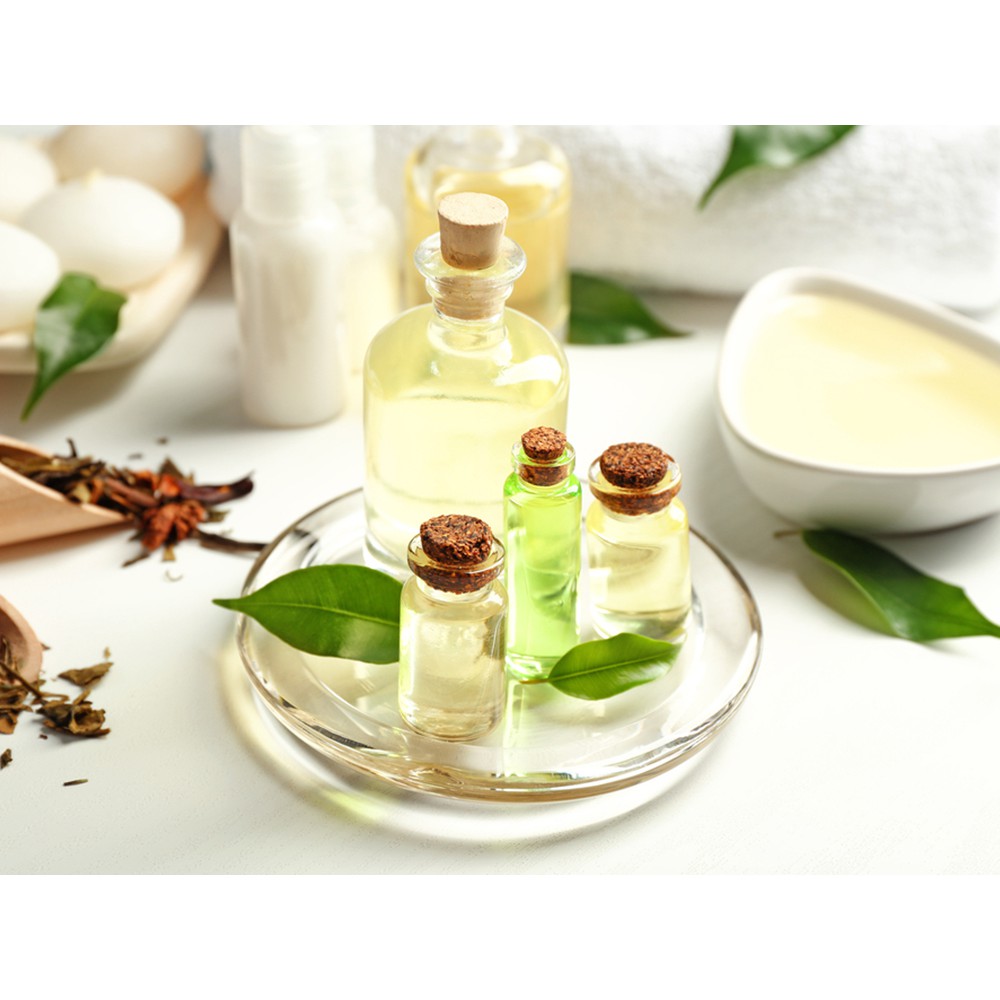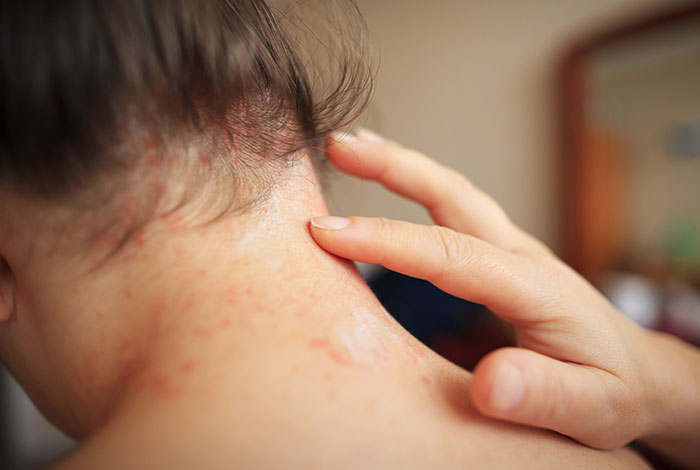Tea tree oil, often hailed as a ‘miracle in a bottle,’ is an essential oil derived primarily from the leaves of the Australian tea tree (Melaleuca alternifolia). Known for its distinctive aroma and pale yellow tint, this natural remedy has been utilized for centuries by indigenous Australians for various medicinal purposes. Its unique combination of antiseptic, anti-inflammatory, and antimicrobial properties has made it a popular choice for many skin-related issues, ranging from acne breakouts to minor wounds.
In recent decades, the global appreciation for holistic and natural remedies has skyrocketed, catapulting tea tree oil to the forefront as a go-to solution for a myriad of skin challenges. Among its many uses, its efficacy in addressing the discomforts of insect bites stands out.
Insect bites, while common, can lead to itching, swelling, and prolonged irritation. As anyone who has experienced the relentless itch of a mosquito bite knows, having an effective remedy on hand can be a true lifesaver.
In this guide, we’ll delve into how you can harness the potent properties of tea tree oil to alleviate the nuisances caused by insect bites. Whether you’re dealing with a pesky mosquito bite, a painful ant bite, or any other insect-induced irritation, read on to discover how this wonder oil can come to your rescue.
Benefits of Tea Tree Oil for Insect Bites
Insect bites, while generally harmless, can be incredibly uncomfortable and at times, quite painful. It’s common to experience a range of symptoms from these bites, including redness, swelling, itching, and sometimes even localized pain.
Recommended: What Does Ginger Tea Taste Like?
Fortunately, tea tree oil, with its unique composition and properties, can be an effective solution to manage and mitigate these symptoms. Here are the primary benefits of using tea tree oil for insect bites:
- Natural Antiseptic Properties
:
- Fights Infection: The skin, when bitten, can sometimes break open, making it susceptible to secondary infections. Tea tree oil’s natural antiseptic properties help combat potential bacterial or fungal growth at the site of the bite, ensuring it remains clean and free from harmful microorganisms.
- Prevents Complications: By keeping the bite area sanitized, tea tree oil can reduce the risk of complications, like cellulitis, which is a skin infection that can be caused by bacteria entering through the bite.
- Reduces Inflammation and Itching
:
- Soothes the Skin: Tea tree oil contains natural anti-inflammatory agents that can reduce the swelling and redness associated with insect bites. This soothing effect can provide immediate relief, especially from bites that cause a burning or stinging sensation.
- Alleviates Itching: One of the most bothersome symptoms of an insect bite is the relentless itch. Thanks to the oil’s anti-inflammatory properties, it can minimize itching, preventing the vicious cycle of scratching and further skin damage.
- Speeds up the Healing Process
:
- Promotes Skin Recovery: When applied to insect bites, tea tree oil can promote faster skin recovery. Its components help with cell regeneration, allowing the skin to heal quicker and reducing the chances of scarring or prolonged irritation.
- Hydrating Effects: While tea tree oil is primarily known for its antiseptic and anti-inflammatory properties, it can also help keep the skin hydrated around the bite. This ensures that the skin remains supple and less prone to dryness or flaking as it heals.
- Natural Repellent
:
- Wards off Insects: Some studies suggest that the strong aroma of tea tree oil can act as a deterrent for certain insects, preventing further bites when applied to the skin.
- Safe for Skin: Unlike some commercial insect repellents that contain chemicals, tea tree oil is a natural alternative. When used appropriately, it can provide protection against insects without the potential side effects of synthetic repellents.
In essence, the multifaceted benefits of tea tree oil make it an invaluable remedy for those unfortunate encounters with insects.
Recommended: Does Chamomile Tea Stain Teeth?
Whether it’s for immediate relief or long-term healing, this essential oil proves to be an ally in our fight against the discomforts of insect bites.

Safety Precautions Before Using Tea Tree Oil
While tea tree oil offers numerous benefits for insect bites and other skin concerns, it’s crucial to use it safely and appropriately. This powerful essential oil can cause adverse reactions if not used correctly.
Here are the key safety precautions to consider before applying tea tree oil:
- Ensure It’s 100% Pure
:
- Avoid Adulterated Oils: Some products on the market mix tea tree oil with other ingredients, diluting its potency and potentially introducing allergens. Always check the label to ensure you’re purchasing 100% pure tea tree oil.
- Watch Out for Fillers: Some manufacturers might add synthetic fillers to extend the volume of their product. These fillers can be harmful or cause allergic reactions, so always buy from reputable brands.
- Potential Allergic Reactions & Patch Test Recommendation
:
- Patch Test: Before applying tea tree oil extensively, it’s wise to conduct a patch test. Apply a small amount of the oil (preferably diluted) on a tiny area of your skin, like the inside of your wrist. Wait for 24 hours to ensure there’s no adverse reaction.
- Identify Signs of Allergy: If you notice redness, itching, burning, or any form of discomfort from the patch test area, it’s a sign that you might be allergic or sensitive to tea tree oil.
- Warning Against Ingestion
:
- Not for Internal Use: Tea tree oil is strictly for topical use. It is toxic when ingested and can lead to serious symptoms like confusion, ataxia, drowsiness, and even coma. Ensure it’s kept out of reach of children and pets.
- Immediate Action: If someone accidentally ingests tea tree oil, seek medical attention immediately.
- Dilution for Sensitive Skin
:
- Avoid Direct Application: Especially for those with sensitive skin, applying tea tree oil directly might be too potent and can cause skin irritation. It’s often recommended to dilute it with a carrier oil.
- Carrier Oils: Common carrier oils to mix with tea tree oil include coconut oil, almond oil, jojoba oil, and olive oil. A general guideline for dilution is adding 3-5 drops of tea tree oil to a teaspoon of the chosen carrier oil. However, this ratio can vary based on personal preference and skin sensitivity.
- Avoid Eye and Mucous Membranes
:
- Sensitive Areas: Be cautious when applying near the eyes, nose, mouth, and other sensitive areas. Tea tree oil can cause a burning sensation and irritation if it comes in contact with mucous membranes.
- In Case of Contact: If tea tree oil accidentally gets into the eyes, rinse immediately with plenty of cool water and seek medical advice if the irritation persists.
- Storage
:
- Keep Away from Sunlight: Store tea tree oil in a cool, dark place. Exposure to sunlight can reduce its efficacy and alter its composition.
- Tightly Sealed: Always ensure the cap is tightly sealed to prevent oxidation and maintain its potency.
Recommended: What Does Jasmine Milk Tea Taste Like?
Remember, as with any natural remedy, what works for one person might not work for another. Always listen to your body, and if you’re ever in doubt, it’s best to consult with a healthcare professional or dermatologist before using tea tree oil.
Step-by-Step Guide to Using Tea Tree Oil for Insect Bites
Insect bites, though often small, can be maddeningly itchy and, if not treated promptly, can lead to secondary issues like infection or hyperpigmentation. Using tea tree oil can be a natural and effective remedy to manage these bites.
Here’s a step-by-step guide on how to use it:
- Clean the Affected Area
:
- Why It’s Important: Before applying any remedy, it’s crucial to ensure the bite site is free from dirt and bacteria, minimizing the risk of infections.
- How-To
:
- Gently wash the insect bite with mild soap and lukewarm water.
- Use a soft cloth or your fingers to clean, avoiding excessive scrubbing.
- Pat the area dry with a clean towel, avoiding rubbing, which can exacerbate the irritation.
- Prepare the Tea Tree Oil Mixture (if diluting)
:
- Dilution is Key for Sensitive Skin: Direct application might be too potent for some. Diluting the oil can reduce the risk of skin irritation without compromising its efficacy.
- How-To
:
- In a small bowl or container, add a teaspoon of your chosen carrier oil (like coconut, almond, or jojoba oil).
- Add 3-5 drops of tea tree oil to the carrier oil. This is a general guideline, but you can adjust based on personal preference and skin sensitivity.
- Mix well until fully combined.
- Application
:
- Direct to the Point: The goal is to target the bite directly to alleviate symptoms and promote healing.
- How-To
:
- Dip a clean cotton ball, swab, or fingertip into the tea tree oil or diluted mixture.
- Gently dab the oil directly onto the insect bite, ensuring it’s covered entirely.
- Allow it to air dry. Avoid covering with tight clothing or bandages immediately to let the skin breathe.
- Reapplication and Maintenance
:
- Consistency is Key: For optimum results, regular application is essential, especially if the bite is particularly bothersome.
- How-To
:
- Reapply the tea tree oil (or diluted mixture) 2-3 times a day, especially after bathing or sweating.
- Monitor the bite’s progression. You should notice reduced itching, swelling, and redness over time.
- If, after several days, the bite worsens, shows signs of infection (like increased redness, warmth, pus, or if red streaks appear), or if you experience an allergic reaction, stop the application and seek medical attention.
Additional Tips:
- Moisturize: After applying tea tree oil and allowing it to dry, consider moisturizing the area with a gentle, hypoallergenic lotion to keep the skin hydrated.
- Avoid Scratching: Scratching can introduce bacteria and lead to infections. If the itch is unbearable, consider over-the-counter itch relief creams or cold compresses as supplementary treatments.
Recommended: What a Tea Bag Does In Warm Water Crosswood
Using tea tree oil for insect bites can offer prompt relief and expedite the healing process. By following this guide and always being cautious of individual skin reactions, one can effectively use this natural remedy to combat the discomforts of insect bites.
Other Uses of Tea Tree Oil for Skin Issues
Tea tree oil, with its unique blend of antimicrobial, anti-inflammatory, and antiseptic properties, is not just limited to treating insect bites. Its versatility makes it a popular choice for various skin concerns.
Let’s delve into some of its other notable uses:
- Acne Treatment
:
- Mechanism: Tea tree oil can target and kill the bacteria responsible for acne, reducing inflammation and preventing future breakouts.
- How-To
:
- After cleansing your face, apply a drop of diluted tea tree oil directly onto the pimple using a cotton swab.
- Let it dry before applying any other skincare products.
- Use daily until the acne clears.
- Fungal Infections
:
- Mechanism: Tea tree oil’s antifungal properties make it effective against issues like athlete’s foot, ringworm, and nail fungus.
- How-To
:
- Clean and dry the affected area.
- Apply diluted tea tree oil with a cotton ball or swab.
- Repeat 2-3 times daily until the infection clears.
- Minor Cuts and Burns
:
- Mechanism: The antiseptic properties of tea tree oil can help cleanse and prevent infections in minor wounds.
- How-To
:
- Clean the wound with mild soap and water.
- Apply a few drops of diluted tea tree oil to the area.
- Cover with a bandage if necessary.
- Dandruff and Scalp Issues
:
- Mechanism: By targeting the fungus responsible for dandruff and its anti-inflammatory properties, tea tree oil can alleviate flakiness and itchiness.
- How-To
:
- Add a few drops of tea tree oil to your shampoo.
- Massage into the scalp and rinse thoroughly.
- Use regularly for best results.
- Eczema and Psoriasis
:
- Mechanism: While not a cure, tea tree oil can help reduce the inflammation, itchiness, and discomfort associated with these conditions.
- How-To
:
- Mix a few drops of tea tree oil with a teaspoon of coconut oil or another soothing carrier oil.
- Apply to the affected area daily or as needed for relief.
- Cold Sores
:
- Mechanism: Its antiviral properties can help speed up the healing process of cold sores and reduce pain.
- How-To
:
- Apply diluted tea tree oil to the cold sore with a clean cotton swab.
- Repeat several times a day until the sore heals.
- Warts
:
- Mechanism: The antiviral and antiseptic properties of tea tree oil can contribute to the drying and eventual shedding of the wart.
- How-To
:
- After cleaning the area, apply undiluted tea tree oil directly to the wart.
- Cover with a bandage and leave overnight.
- Repeat daily until the wart disappears.
When considering tea tree oil for any skin issue, it’s essential to remember that while many people find relief using this natural remedy, results can vary. Additionally, it’s vital to use tea tree oil safely, being aware of potential skin sensitivities, and always conducting a patch test before broader application.
Recommended: Does Panera Green Tea Have Caffeine?
If skin problems persist or worsen, consulting with a dermatologist or healthcare professional is recommended.

Alternative Natural Remedies for Insect Bites
Insect bites are a common ailment, especially during warmer months or in certain geographical locations. While tea tree oil is a popular choice for treating these bites, there are several other natural remedies that have been traditionally used to alleviate the itching, swelling, and discomfort associated with insect bites.
Here’s a list of some alternative natural remedies:
- Aloe Vera
:
- Properties: Known for its soothing and anti-inflammatory effects, aloe vera can reduce redness and itchiness from insect bites.
- How-To
:
- Extract the gel from an aloe vera leaf.
- Apply directly to the bite.
- Reapply as needed.
- Lavender Essential Oil
:
- Properties: Lavender oil has antiseptic and anti-inflammatory properties.
- How-To
:
- Dilute a few drops in a carrier oil.
- Apply to the bite for relief.
- Baking Soda
:
- Properties: Baking soda (sodium bicarbonate) can neutralize the pH of the skin, reducing itchiness.
- How-To
:
- Make a paste with baking soda and a little water.
- Apply to the bite and leave on for about 10 minutes before rinsing off.
- Apple Cider Vinegar
:
- Properties: Its acidic nature can help neutralize the itch and acts as an antiseptic.
- How-To
:
- Dab a little apple cider vinegar directly onto the bite.
- If you have sensitive skin, dilute it with water first.
- Honey
:
- Properties: Honey has natural anti-bacterial properties and can reduce inflammation.
- How-To
:
- Apply a small amount of raw honey directly to the bite.
- Rinse off after about 30 minutes.
- Calendula
:
- Properties: Calendula has anti-inflammatory and healing properties.
- How-To
:
- Apply calendula cream or gel directly to the bite.
- Reapply as needed.
- Basil Leaves
:
- Properties: Basil contains eugenol, which can help relieve itching.
- How-To
:
- Crush fresh basil leaves to release the juice.
- Apply directly to the insect bite.
- Cold Compress
:
- Properties: The cold can reduce inflammation and numb the area, providing immediate relief from itching and burning.
- How-To
:
- Wrap ice or a cold pack in a cloth.
- Apply to the bite for 10-15 minutes.
- Oatmeal
:
- Properties: Oatmeal has anti-inflammatory properties and can soothe irritated skin.
- How-To
:
- Make a paste with ground oatmeal and a little water.
- Apply directly to the bite and rinse off after about 10 minutes.
- Witch Hazel
:
- Properties: Witch hazel has astringent properties that can reduce itching and swelling.
- How-To
:
- Apply witch hazel extract directly to the bite using a cotton ball.
While all these remedies can offer relief from insect bites, it’s crucial to note that everyone’s skin can react differently. Always conduct a patch test when trying a new remedy, especially if you have sensitive skin.
Recommended: Is Chai Tea Good For Sore Throat?
If an insect bite becomes severely inflamed, continues to worsen, or shows signs of an allergic reaction, it’s essential to seek medical attention promptly.
Conclusion
Insect bites, though often minor, can bring about discomfort that disrupts our daily lives. While tea tree oil stands as a prominent natural remedy, it’s heartening to know there’s a plethora of alternatives, from aloe vera to oatmeal, that can equally offer relief.
As with all natural treatments, it’s essential to proceed with caution, respecting individual skin sensitivities. By arming ourselves with knowledge and options, we can navigate the itch and inflammation of insect bites more confidently, ensuring a comfortable and holistic approach to skin care.
